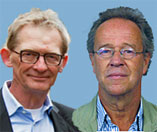What PHC can do regarding the health of workers - Alma Ata 1978 revisited
 WONCA News has begun a regular feature on the subject of Occupational Health including useful resources for clinical practice. Peter Buijs (right) & Frank van Dijk (left) are the promotors and main authors, they are Dutch occupational physicians and former family doctors, and for many years active in ICOH. In this contribution, they deal with a review, commissioned by the WHO, and written by them on interventions in Primary Health Care regarding the health of workers. In the next edition (August), they will tell more about successful examples from different countries where PHC is paying more attention to work issues.
WONCA News has begun a regular feature on the subject of Occupational Health including useful resources for clinical practice. Peter Buijs (right) & Frank van Dijk (left) are the promotors and main authors, they are Dutch occupational physicians and former family doctors, and for many years active in ICOH. In this contribution, they deal with a review, commissioned by the WHO, and written by them on interventions in Primary Health Care regarding the health of workers. In the next edition (August), they will tell more about successful examples from different countries where PHC is paying more attention to work issues.
Worldwide there are a tremendous amount of work-related health problems. As the tip of this iceberg, Takala (2014) estimates a work-related death toll of 2.3 million workers annually. In industrialized countries, non-communicable diseases are overwhelming examples of work-related diseases. The economic costs vary between 1.8 and 6.0% of the GDP in country estimates (average 4%). Involuntary early retirement enhances those costs considerably (for example, in Finland: up to 15% of GDP). Work may cause or aggravate diseases, injuries or disorders: such as traffic injuries, mental disorders, musculoskeletal and respiratory diseases. On the other hand, having a job appears to be a crucial prerequisite not only for your income, but often also for your health and wellbeing (Waddell & Burton, 2006).
Why does this concern PHC professionals who are already very busy?
Only about 15% of the global workforce has access to Occupational Health Services. So for 85% of the global workforce, PHC is the first and often only medical care. Even when enough occupational physicians are available, like in the Netherlands, many work-related health problems present first in PHC, but are often not recognized by GPs, who are often not well trained to do so (Buijs, Gunneyon, van Weel, 2012)
However, in a recent review, commissioned by the WHO (Buijs, van Dijk, TNO*, 2014), concerning what PHC does and can do regarding workers’ health, we found quite a lot PHC work-related activities all over the globe: from small-scale initiatives improving daily practice to large-scale programs involving thousands of professionals and millions of workers (Thailand, China, UK). These activities appear to cover three work-related interventions:
1. Emergency treatment and consultations of workers regarding their health and work ability. These are often related to chronic medical conditions, aiming at return to work under good conditions (tertiary prevention)
2. Health examinations for early detection of work-related and occupational diseases (secondary prevention)
3. Education and training in prevention and health promotion; workplace visits in communities where agriculture or a specific industry is dominant (primary prevention)
These activities are only feasible under specific conditions like adequate government support, organizations at district level able to offer help from occupational health experts, referral options to occupational health clinicians, a website and helpdesk.
Waiting for extensive programs is not needed: improvements on a smaller scale can also be important for daily practice, and well feasible. Examples are:
• questioning patients about working conditions
• taking a good occupational history
• providing PHC with appropriate tools for identification and control of occupational and work-related diseases, accidents and work disability
• encouraging collaboration between PHC and occupational health care when available
Take home message
Our report shows, that work is very important for patients, as a possible cause for health problems, but certainly also as an important condition for your income, health and wellbeing. Many work-related complaints are presented at PHC level, and can be handled there, provided better education and support is organized.
Last but not least we advocate developing and funding comprehensive research and development programs in this quite unexplored territory, to support innovative practice, education and scientific evaluation.
Of course PHC cannot replace high quality multidisciplinary occupational health services operating parallel to and strengthening PHC.
Finally full coverage of the global workforce - the backbone of all economies - with professional support of workers’ health is needed, especially for vulnerable workers in small enterprises, in agriculture and in the informal economy†, people with handicaps or chronic medical conditions. PHC can play a crucial role, especially for these groups of workers, being well-positioned to connect to them. This would mean a revival of the famous WHO 1978 Alma Ata Declaration: bringing PHC as close as possible to where people live
and work!
References
Buijs PC, Dijk FJH van. ‘Essential interventions on Workers’ Health by Primary Health Care; A scoping review of the literature’. TNO*, 2014.
Available here
Takala J, Hämäläinen P, Saarela KL, Yun LY, Manickam K, Jin TW, Heng P, Tjong C, Kheng LG, Lim S, Lin GS. Global estimates of the burden of injury and illness at work in 2012.
J Occup Environ Hyg. 2014;11:326-37.
Waddell G, Burton AK. Is work good for your health and wellbeing? London: The Stationery Office, 2006,
www.dwp.gov.uk/docs/hwwb-is-work-good-for-you.pdf
Buijs PC, Gunneyon B, Weel C van. Primary health care: what role for occupational health? Editorial.
BJGP, 2012; 623-624.
Notes
* Toegepast Natuurkundig Onderzoek
† The informal sector, informal economy, or grey economy is the part of an economy that is neither taxed, nor monitored by any form of government.